We spent our first few days in Rodrigues completing our clearance, getting a few boat projects done and exploring the area around Port Mathurin. We also picked up a SIM card for cellular data–it’s great to have always-on connectivity again after running for so many days on BGAN.
Trip highlights from September 12th through 16th follow. Click any image for a larger view, or click the position to view the location on a map. And a live map of our current route and most recent log entries always is available at http://mvdirona.com/maps
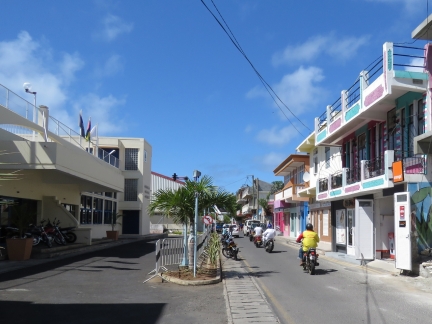 |
Rue Wolphart Hamenssen
Position: 63 25.22, -19 40.87
A first view to the town of Port Mathurin along Rue Wolphart Hamenssen. Rodrigues was a French colony from 1735 until 1809 when Britain took control. Mauritius gained independence from Britan over 150 years later in 1967, but the original French influence still seems stronger than that of the British. Creole is the native language, but a large percentage of the population can English as well. One notable British influence is that Mauritians drives on the left side of the road. Scooters and motorcycles are the most common form of transport through the narrow streets. Small cars and trucks also were popular, but we saw suprisingly few bicycles.
|
 |
MCB
Position: 63 25.22, -19 41.00
After clearing through, the next task was to get some local currency (Mauritius Rupees) at the Mauritius Commercial Bank ATM.
|
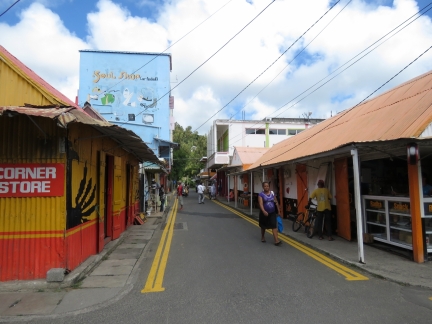 |
Rue Pere Gandy
Position: 63 25.28, -19 40.92
Looking south along Rue Pere Gandy. We’d arrived shortly before noon on a Saturday and most of the businesses that were open had shut down by 2pm. As we walked around, the streets got less and less busy.
|
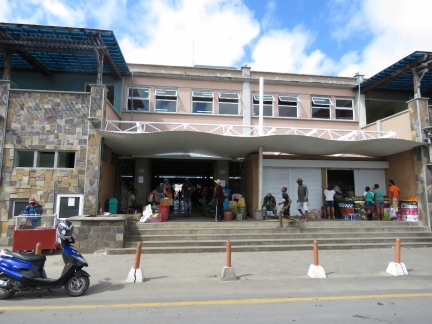 |
Market
Position: 63 25.39, -19 40.80
The Rodrigues market is open every day, but Saturday morning is the big market event. A few vendors were still open, but many had already packed up.
|
 |
SIM card
Position: 63 25.27, -19 40.87
Signs for the local cellular company Orange were everywhere and we were hoping to get setup with cellular data today. We could purcahse a SIM card, but couldn’t enable it until Monday when the local Orange office opens for business.
|
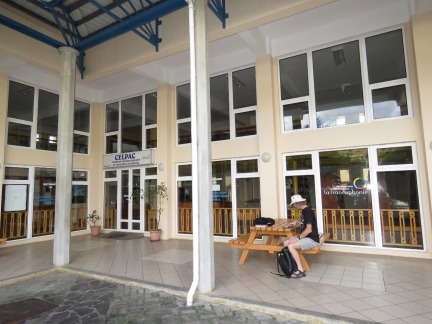 |
Library
Position: 63 25.32, -19 40.89
The library has free WiFi, but they disable it outside library hours. Since the library had closed for the day, we couldn’t connect there either.
|
 |
Skiffs
Position: 63 25.67, -19 40.61
Sturdy skiffs such as these were moored all along the shore. We often saw people out fishing in them, powering the craft by pole, oar or sail.
|
 |
Cemetery
Position: 63 25.88, -19 40.52
We passed two large catholic cemeteries on a walk east to Anse aux Anglaise.
|
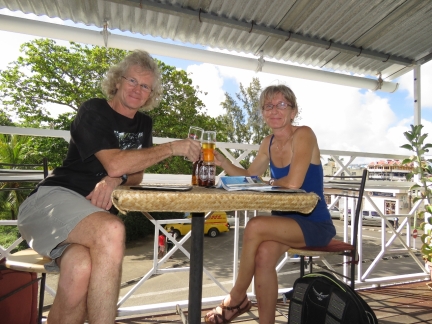 |
Aux Deux Freres
Position: 63 25.42, -19 40.85
Enjoying the local brew, Phoenix, and free WiFi on the balcony of Aux Deux Freres.
|
 |
Oil change
Position: 63 25.23, -19 40.84
Changing the main engine oil after the 461-hour Indian Ocean crossing. This is the first time we’ve exceeded the oil change interval of 250-375 hours (depending on oil used), but shutting the main engine down to change the oil in the middle of the crossing did not seem worth the risk. We’ve heard too many stories of people not being able to restart the engine in those situations. We have been changing the oil on the longer 375-hour interval, but even still this is our fifth oil change this calendar year—we have been covering a lot of ground recently. On the right of the photo is our oil storage system. We stack pails two-high and secure them with a fitted marine board base and cover, all held in place with a ratchet strap. When designing the boat, we were initially planning to have an oil storage area built-in along with one for gasoline. We’re really glad we couldn’t find a solution to locating those, as having portable containers is much more convenient. Being able to get oil, gasoline and diesel all in the same place has been rare on this trip and we’re often having to transport oil and gas a fair distance from where the boat is moored.
|
 |
Fuel filter
Position: 63 25.23, -19 40.84
We switched fuel filters during the crossing and replaced the old one today. You can see the old filter has a lot of black residue on the folds after 700 hours. This is either asphaltenes settling out, or evidence of some algae growth.
|
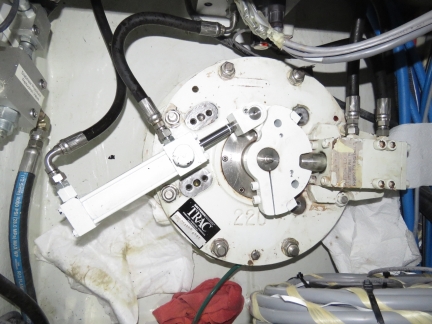 |
Actuator
Position: 63 25.23, -19 40.84
The service period for the hydraulic actuator (the cylindrical hydraulic ram at the left of the photo) is 2,000 hours or 6 years. Because this part typically gives considerable warning prior to failure, we usually don’t replace it until it starts showing signs of wear. This unit continues to run fine at 2,865 hours, but is leaking a bit of oil so it’s time for a change. These units can be changed underway by just disabling the stabilizer that’s being serviced, but we typically service them at anchorage.
|
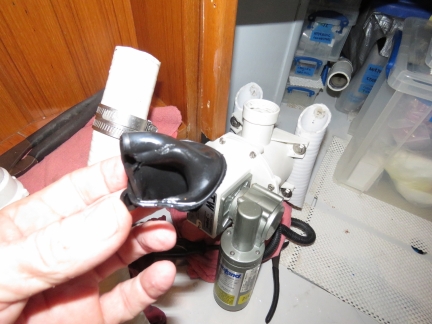 |
Gray water pump
Position: 63 25.23, -19 40.84
We had an obstruction in the outlet of the gray water system in Darwin, which we addressed, but the pump output has been poor since then. So we took it apart today and found out why. The inlet valve had been ripped and inverted, likely by overpressure from the obstruction.
|
 |
Spitfire
Position: 63 25.23, -19 40.84
Whenever we open up a storage area, Spitfire has to investigate. Here he is leaping out of what Jennifer calls “the most awful place” to get spares out of. We’d had it open to retrieve the gray water pump parts.
|
 |
O-ring
Position: 63 25.23, -19 40.84
We noticed black, oily “dust” sprayed around near the steering in the lazarette. Upon closer inspection, we found the source was microscopic bits of oil leaking past a rear thruster o-ring, carrying with it o-ring residue. A 10-cent o-ring and a 10-minute cleanup and it’s back to 100% operational. We’re glad to have found that one before it was a real leak.
|
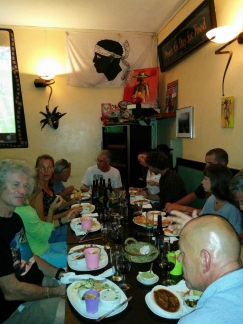 |
Blue Marlin
Position: 63 26.00, -19 40.49
Dinner with other cruisers at the Blue Marlin in Anse aux Anglaise. Seated on James’ left in a lime-colored jacket is Mareike Guhr, skipper of La Medianoche who we’d met and last seen at Lizard Island. It was great to see Mareike again.
|
 |
Clearing the basin
Position: 63 25.35, -19 40.46
The regular supply ship is arriving this morning, so all boats must clear the jetty and the inner harbour to allow room for the ship to maneuver onto the jetty. We’re all going to anchor in the outer harbour for a couple of hours while it arrives and docks.
|
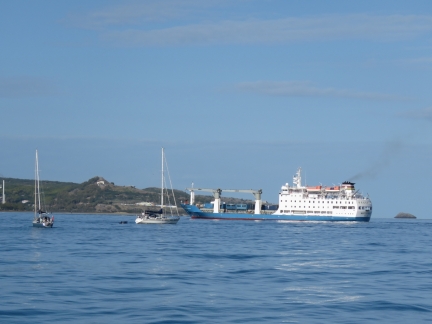 |
Supply ship
Position: 63 25.99, -19 39.87
The supply ship arriving into Rodrigues from Mauritius. It’s quite a bit larger than we were expecting.
|
 |
Boat day
Position: 63 25.26, -19 40.86
The streets were much busier than we’d seen them so far. Partly it was a Monday morning, but much of the activity seemed centered around the arrival of the supply ship.
|
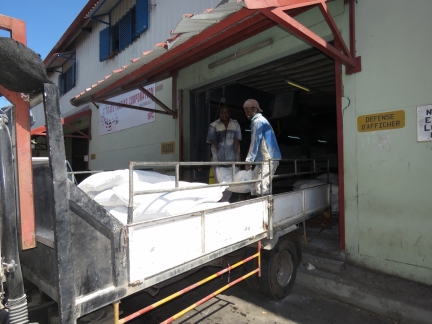 |
Unloading
Position: 63 25.26, -19 40.86
All along the street, goods were being transferred by hand from the ship to waiting trucks. We’re not sure what was in those big white bags, but they looked very heavy.
|
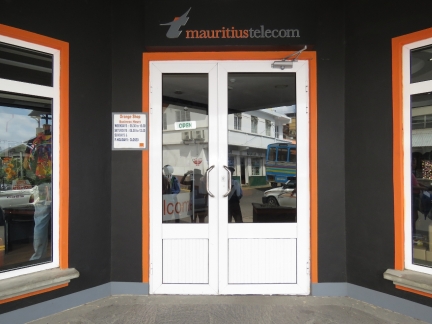 |
Orange
Position: 63 25.40, -19 40.81
We finally could get a cellular data SIM card. Data rates here were surprisingly inexpensive: 50Gig for 3,000 Rupees (about 85 USD).
|
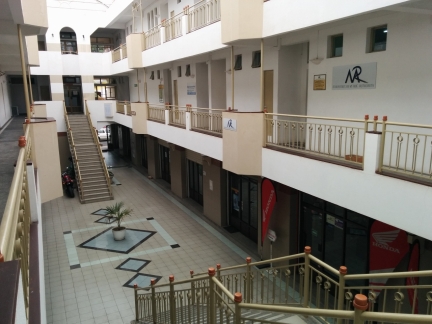 |
MRA
Position: 63 25.36, -19 40.93
Customs and immigration don’t charge a fee for clearance during regular business hours of Monday through Friday and Saturday until noon. But we’d arrived shortly before noon on Saturday and our clearance extended into their overtime period and incurred a $1000 Rupee overtime fee (about $28 USD). The officials don’t handle payments, so we had to go to Mauritian Revenue Authority (MRA) office on Monday to pay.
|
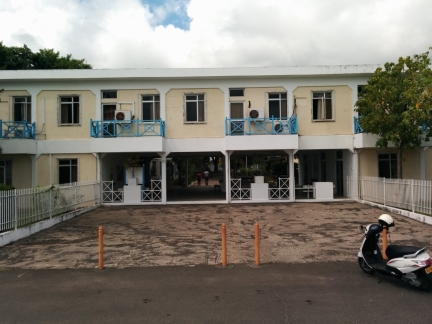 |
Cashier
Position: 63 25.29, -19 40.78
Quarantine charges a standard clearance fee of $1800 Rupees, or about $50 USD. We needed to go to a separate cashier to pay that bill.
|
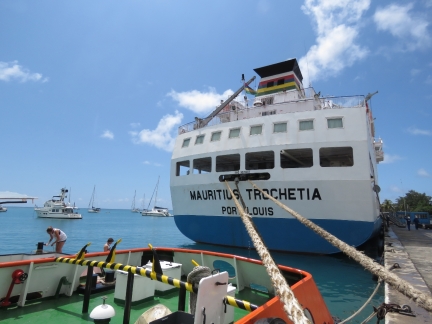 |
Mauritius Trochetia
Position: 63 25.19, -19 40.86
The supply ship Mauritius Trochetia on the jetty with Dirona visible at anchor to the left. The anchorage is quite small and crowded, with a fairly strong river current where we are. We held well, but barely had room for 3:1 scope (ratio of anchor chain to depth), while we prefer at least 5:1.
|
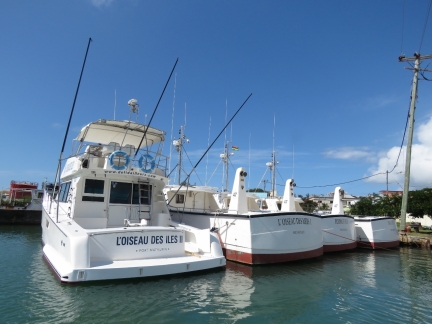 |
Basin
Position: 63 25.08, -19 40.98
Just west of the harbour is a small basin with about a dozen small power boats moored inside and a couple of dozen smaller fishing skiffs.
|
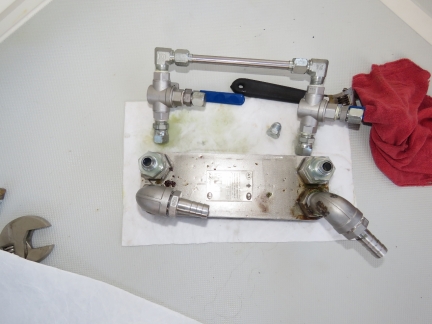 |
Fuel cooler
Position: 63 25.20, -19 40.79
We’d noticed some brown-colored saltwater along the lazarette floor by the engine room door and traced it back to the fuel cooler we’d installed at the Gold Coast. The stainless 90-degree L-fittings at the bottom of the photo appeared to have a manufacturing problem where the stainless steel was porous and the fittings leaked out of multiple holes after only six months. James removed the fittings and was able to reroute the hoses to re-install the cooler without the failed fittings.
|
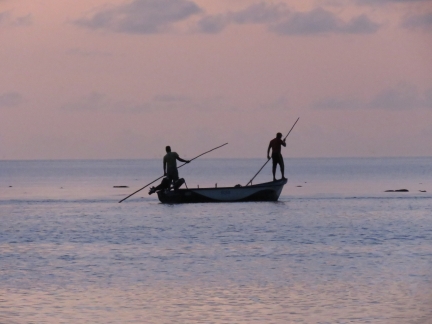 |
Fishing
Position: 63 25.20, -19 40.79
Locals fishing off the reef at dusk.
|
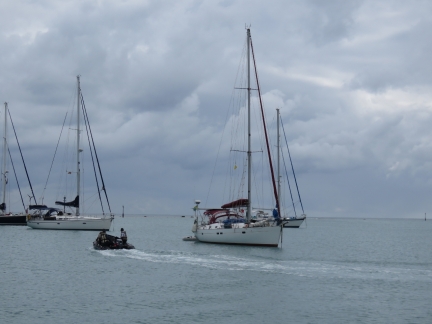 |
Clearing through
Position: 63 25.20, -19 40.79
The supply ship fills the jetty, so the Coast Guard ferries officials out to clear arriving boats.
|
 |
Cattle car
Position: 63 25.20, -19 40.79
The supply ship seemed to have an enormous hold–we watched container after container come out yesterday. Today they filled the ship in preparation for tomorrow’s departure. The last containers to go on contained cattle in specially-designed containers.
|
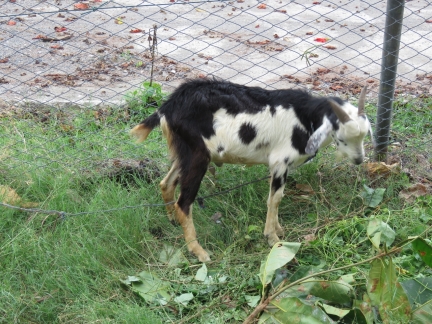 |
Goat
Position: 63 25.16, -19 40.91
Goats and other livestock are common along the streets of Port Mathurin.
|
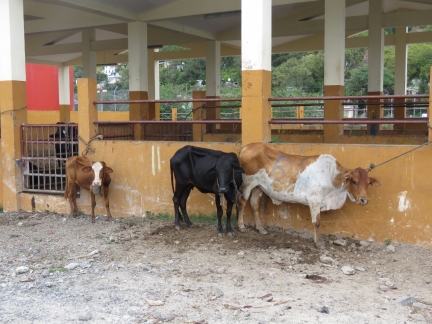 |
Cattle
Position: 63 25.10, -19 40.90
We thought we could hear cows mooing in the port early this morning and later found the source: a large loading area where cattle are led into containers for loading onto the supply ship.
|
 |
View
Position: 63 25.02, -19 41.23
From the harbour we could see a cross atop a hill that looked to be an excellent viewpoint. So we followed a paved road up behind the sports field and dirt road to the top. This is the view, with Port Mathurin slightly right of center and Pointe La Gueule to the southwest on the left.
|
 |
Port Mathurin
Position: 63 25.02, -19 41.23
A close-up of Port Mathurin from the viewpoint.
|
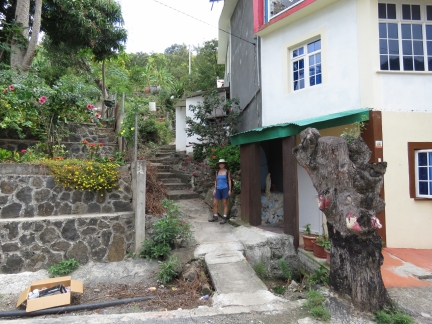 |
Shortcut
Position: 63 25.06, -19 41.10
We followed the road to reach the viewpoint, but once there found a more direct route back down marked with red paint. The shortcut came out on a set of stone steps into a small lane off the main road, where it makes a hairpin turn just beyond the entry to the sports field.
|
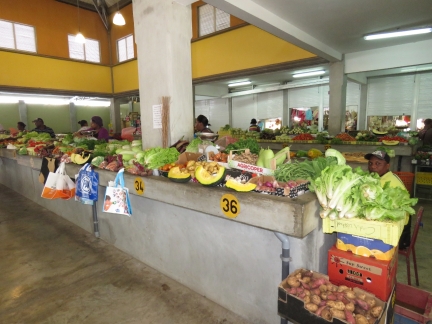 |
Market
Position: 63 25.39, -19 40.80
We made a quick pass through the market building–lots of produce was still for sale even in the early afternoon.
|
 |
Freshwater pump
Position: 63 25.20, -19 40.79
We have two house freshwater pumps installed. If one fails, we can just switch over to the other. And we carry a third as a spare. The main pump failed today, so we replaced it with spare and are back to two operational pumps.
|
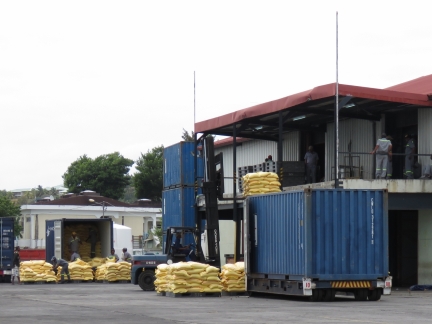 |
Unloading
Position: 63 25.21, -19 40.85
All boats need to be out of the harbour when the supply ship comes and goes. So we left the anchorage this morning and later returned to the jetty in preparation for tomorrow’s fueling. Processing the containers takes several days after the supply ship is gone. Here workers are manually unloading containers of heavy yellow bags onto an adjacent pallet. A forklift carries the pallets up to the second floor of the port building where another set of workers manually unloads the pallets into the building.
|
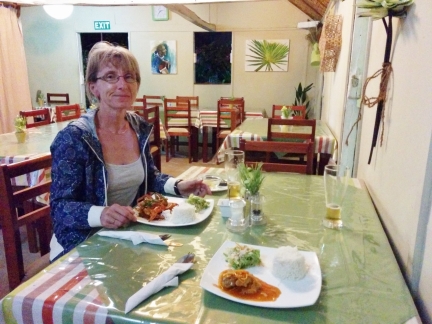 |
Tirozo
Position: 63 25.28, -19 41.01
We had a delicious seafood meal at Tirozo just up the road from the port.
|

|
Click the travel log icon on the left to see these locations on a map, with the complete log of our cruise.
On the map page, clicking on a camera or text icon will display a picture and/or log entry for that location, and clicking on the smaller icons along the route will display latitude, longitude and other navigation data for that location. And a live map of our current route and most recent log entries always is available at http://mvdirona.com/maps. |
If your comment doesn't show up right away, send us email and we'll dredge it out of the spam filter.

Thank you both for taking the time to blog your travels. We have enjoyed both your post and book as we have traveled throughout the Northwest.
I wanted to ask you what micron fuel filter you use in the Racor, and assuming your engine has primary fuel filters, what micron they are as well.
Thanks again,
Jim and Rosy Addington
M/V Sea Venture
Thanks for the feedback on the blog. You were asking about fuel filtration. The way we run is we pass all fuel from the bulk tanks to the day tank (wing) or the supply tanks (main and all engines but the wing) through a large commercial 25 micron filter. From the supply tank, the fuel is pulled through a 2 micron Racor 900. Then there are two more filters on engine, a 10 micron and a 2 micron.
It’s unusual to use such a fine primary filter but we like to catch all we can there because 1) they are cheap at $13 rather than $140 for the on-engine pari, 2) they can be changed without shutting down the engine, and 3) we have a lot of them (more than 40 spare filters on board).
There is more details on the design and the thinkning behind it at: http://www.electronics-tutorials.ws/transistor/tran_7.html
Very cool. Will be looking for your arrival. I love the videos where you leave in the natural sounds too. Much better then music drowning out what makes us all go to sea. :)
Our current planned arrival time in Reunion is just past 7am local time tomorrow morning (9/24). Current weather is calm and the currents are so incredibly positive that we are cruising along at 1.8 nautical miles per gallon at 6.8 kts. It’s been like that for more than a day. With these currents, our effective range is way up over 5,000 nm. We wish it was like this all the time or the surface currents were more accurately predicted.
The Mauritious mainliand is in sight and we expect to pass about 4 nm south of it in about 5 hours. A couple of miles before that, we’ll pass the exact 1/2 way point in our trip around the world.
Alright your underway again!!!!! I am one of those boat geeks who like the operation of the boat so I am much happier to see you on the move. :)
Good hearing from you Tim. It’s just daybreak here at 5:17am. I got back on watch at 4am. The boat is running well and the currents are unusually strong and directly behind us. We are currently travelling at 7.1 kts at a very high 2.10 nm/gallon. We have the fuel to run any speed we like on this crossing but we don’t want to get into Reunion before daybreak so we’ll be averaging rigth around 6.8 kts.